The Apple iPad Pro Review
by Ryan Smith, Joshua Ho & Brandon Chester on January 22, 2016 8:10 AM ESTBattery Life
Battery life is important beyond any doubt. No one wants a tablet or phone that can only spend three hours away from a charger before it dies, no matter how good the device is. While such battery life might be incredible for a desktop replacement or anything else that realistically spends most of its life plugged into a charger, mobile devices are usually carried on the go and used far away from a charger for significant amounts of time. Probably the ultimate example of this is travel, where one might use a tablet to watch movies and browse the internet for a few hours over the course of a flight.
As a result, a significant portion of our reviewing efforts are devoted to determining battery life. In order to quantify battery life, there are inevitably a lot of test cases to cover. Some people might spend most of their time in an e-reader app, others might spend most of their time playing games or similarly intensive tasks on their phones. There’s no real standard for usage, so a tablet that might last a day for one person could last a week. As a result, the goal of our testing is to provide a useful relative comparison. In order to do this, we attempt to equalize for variables like display brightness by setting all displays to 200 nits for battery life testing. Due to the inability to completely eliminate the variables that come with live network testing, we also use strong network reception with high throughput on LTE to ensure that things like power amplifiers are either at a low power setting or bypassed entirely.
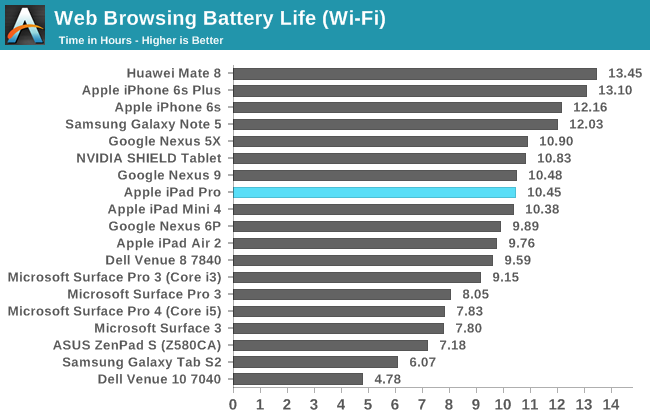
Our first test is the venerable web browsing test, in which we load a selection of web pages from full charge until the device shuts off from lack of battery charge. In WiFi battery life is pretty much identical to the iPad Air 2, which might be surprising given that the battery is only 41% larger. That might sound like a lot, but the display of the iPad Pro is 77% larger at the same 264 PPI pixel density, which means that there’s a pretty sizeable efficiency gap between the iPad Air 2 and iPad Pro. The improved display and SoC are likely to be the main reasons for this, as the 20nm SoC process that was used to make the A8 SoC was quite leaky due to its traditional planar transistor structure compared to the FinFET process used in the A9X.
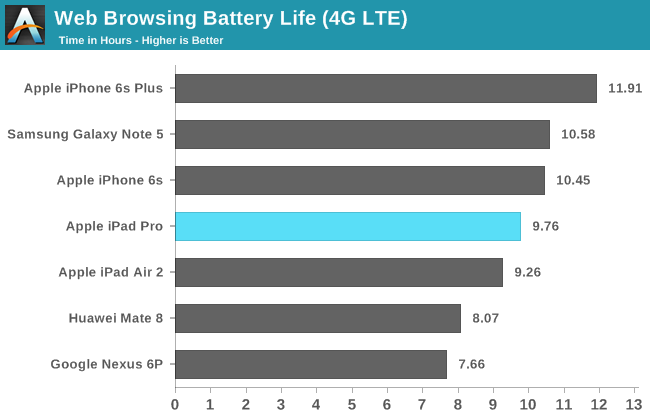
Interestingly, for whatever reason when re-running the same test on LTE battery life is noticeably different when compared to the iPad Air 2, where LTE and WiFi battery life were relatively close. I suspect that RF power is pretty similar between the two devices, but due to efficiency improvements on the display/SoC side the difference in battery life due to additional RF power consumption is magnified.

The more interesting test result that I encountered over the course of battery life testing was our tablet video rundown test. For whatever reason, web browsing clearly lasts a decent amount longer. It's pretty unlikely that the web browser has a lower SoC load when video is basically entirely dependent upon fixed function hardware decode. The most plausible explanation here for me is that we're seeing differences that arise from panel self-refresh, which can kick in on our web browsing test while the same definitely doesn't hold for our video test, which basically requires at least 30 FPS refresh rate continuously for the entire duration of the test. Overall that this makes the iPad Pro worse for content consumption, given Apple's content creation goals, is an unexpected turn of events.
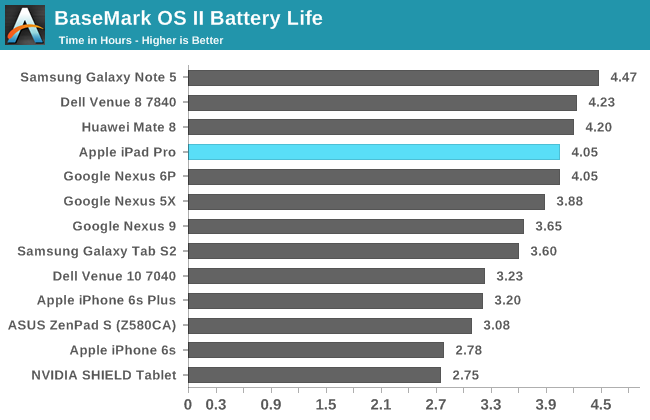
Moving on to the more SoC-bound tasks, we can start by looking at Basemark OS II, which is basically a CPU power virus that can be used to examine the upper bound for device TDP, in addition to nominal sustained CPU load. It’s evident from this test and some back of the envelope calculation that total device TDP excluding display power is roughly 5W, which is about right given the size of the device. This suggests that the A9X can be directly compared to Intel’s Core M in both performance and power, for better or for worse. Performance here is good, with relatively low throttling due to the use of a FinFET process and solid implementation of the Twister architecture.

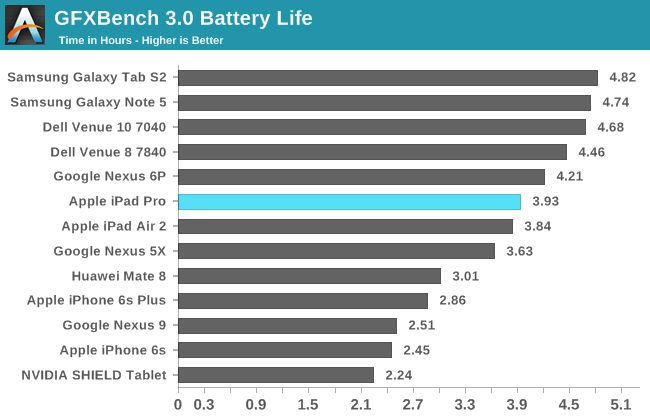
In our GPU throttling test, the A9X has effectively made it impossible to actually use T-Rex as a throttling test as it’s essentially pegged at vsync for the entire duration of the test. The iPad Pro also lasts a similar amount of time here as on the Basemark OS II test, which suggests that this test is still reaching TDP limits for the GPU, even if it doesn't manifest in the form of reduced performance.
Charge Time
While battery life is important, any time you’re dealing with a mobile device the time it takes to charge the battery is important as well. The usual example here is travel, but simply forgetting to plug in a device overnight can show the importance of charge rate. In the case of the iPad Pro, Apple ships it with their usual 12W charger. One might be tempted to suggest that the battery would be charged in about 3.5 hours, but it’s necessary to get the data and avoid speculation on something like this. In order to test how quickly the iPad Pro charges, we measure the difference in time between first plugging in a fully discharged tablet and when the charge is complete based upon power draw at the AC adapter.
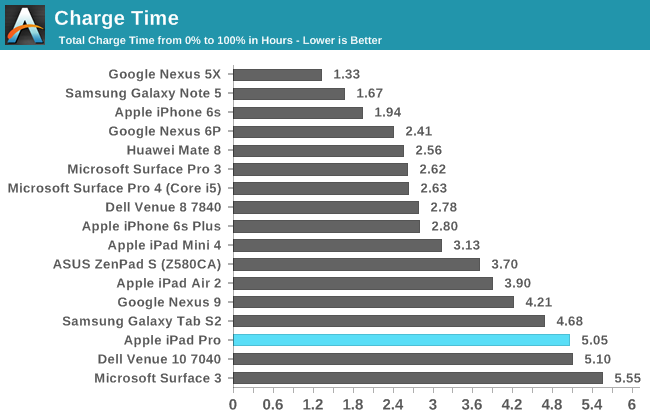
Interestingly, the iPad Pro takes a pretty significant amount of time to charge, at over a full hour longer than the iPad Air 2. While some might be okay with this, it’s definitely a sore spot for the iPad Pro as a higher voltage charger would be able to charge the device at a more acceptable rate. I’m not really sure why Apple decided to go this route, but there’s really no clear solution here unlike the case of the iPhone 6s Plus. The charger also definitely isn’t enough to ensure that you’re always charging the iPad Pro while in use either if the SoC is in overdrive/turbo states as thermally constrained power draw is already around 9-10W.
Despite the long charge time, overall the iPad Pro is quite mobile. However, it does regress somewhat relative to the iPad Air 2 due to its longer charge time, even if battery life is equivalent. Depending upon your use case though it might be difficult, if not impossible to tell the difference.











408 Comments
View All Comments
Alecgold - Sunday, March 13, 2016 - link
Funny you know so well what Apple should(n't) do.Did you look at the tear-down from iFixit on the Pencil? It has some nice, even wonderful, technology inside. It's not a "dumb" pencil that costs 50-65 bucks on a Wacom board and only holds a copper coil. (I know, yes, I'm exaggerating.)
I bought a power- adapter and it came with 4 different wall-plug-prong-thing-adapters. I just needed one, lots of companies do ship region/country specific these days. Did I pay extra for them? No. Did I pay for them? You bet. Even if it was just 15ct. But it's not just the 15ct, it's also the waste that was generated.
Could Apple include everything to the iPad Pro, complete with kitchen sink? Yes. Would I appreciate it? Most likely not, don’t you think? I think most people wouldn’t appreciate it, they already have a kitchen sink.
As I wrote before, it is expensive. But it's not like it is a Louis Vuiton bag, Bugatti Veyron or golden Mont Blanc pen. And even if it is in the same category for you, why don't you buy an Android or Windows tablet?
If you don't want the iPad Pro, don't buy it. If you can't buy it, I'm sorry for that, but it's not something that is going to be solved by grumbling on Anandtech.
One other thing. Am I a professional? Well, according to the Oxford dictionary:
1 Relating to or belonging to a profession: young professional people
1.1 Worthy of or appropriate to a professional person; competent, skilful, or assured:
- his professional expertise
- their music is both memorable and professional
2 Engaged in a specified activity as one’s main paid occupation rather than as an amateur
I pretty sure both 1.1 and 2 apply to me, so I guess I’m a professional.
Being a professional I do have another life and while my professional life might keep me busy burning the midnight oil every now and then, I prefer to do so in a well lit environment.
And at a desk or at the diner table or… It’s much better for your posture to sit upright and not slouch about. Try it!
If I need to read large amounts of text, I snap the keyboard off and sit relaxed with just the tablet.
ams0129 - Wednesday, February 17, 2016 - link
I do not think it is fair to compare and iPad pro with a Surface. The Surface has a full operating system while the iPad pro does not. To me a true iPad pro would pack a core processor and OSX. However, this would create a problem for Apple as it would take away sales from the MacBook Air line.darwiniandude - Monday, February 29, 2016 - link
iPad already far outsells Mac line. And iPhone even more so. There are a billion active iOS devices in use. OS X and iOS share the same kernel and much of the same API's and frameworks. Except one is designed for touch, and the other for classic computing duties. This "full operating system" phrase I hear thrown about makes me laugh because Windows is still a pain to maintain and has no proper audio support, and requires constant hand holding. A secure, reliable, sandboxed Unox application platform (iOS) is far more productive for me.Delton Esteves - Wednesday, March 9, 2016 - link
That's a joke, right?s.yu - Tuesday, March 1, 2016 - link
Very informative review as usual! The performance of the A9X was certainly lower than what the initial hype indicated. Other aspects can basically be summed up by reading a dozen other not-so-informative reviews;)One thing is that AdobeRGB was not tested for, but from the looks of it the screen certainly doesn't cover it either, another aspect that's not as "pro" as Apple made it seem. That said, SP4 as well as MSB are too "consumer" too, in terms of color coverage.
SL1990 - Wednesday, March 9, 2016 - link
Anyone notice while charging Ipad Pro back metal area can feel the vibration. It's that normal??Constructor - Friday, March 11, 2016 - link
Yes, pretty much, for any devices which have a metal case and no grounding lead on the mains power plug.It depends on the circumstances, but basically it has to do with some very small residual capacitive coupling of the supply AC through the charger. Depending on your electrical installation it may go away when you just plug the charger in the other way.
But it's not dangerous (there is no actual connection to the power grid), just a minor inconvenience. It's not Apple-specific, though.
ifrpilot - Friday, April 29, 2016 - link
Funny comments here. If you like iOS and iPad, buy one. If you like Android or a Windows device, buy one of those. As for people making comments about less professional software for iOS - that's just crap. Just the medical industry alone has hundreds of pro apps, let alone aviation, product management, delivery, management services and more. If someone is so anti Apple, why are you wasting your time reading this article, go read about someone else's hardware.